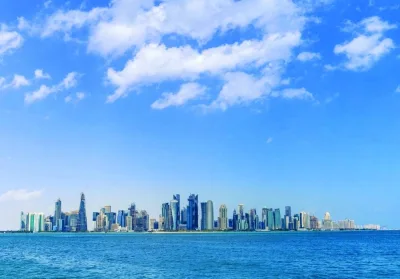HSBC “remains upbeat” on Qatar’s near and long-term prospects, with an already robust outlook now bolstered by rising oil prices and even stronger gains in natural gas receipts.
“Trade data for the first ten months of 2021 gives a sense of the windfall higher energy receipts have brought, with export earnings receipts up more than 60% y-o-y, leaving Qatar with a trade surplus of around 30% of GDP,” HSBC Global Research said on Thursday.
“We estimate that these strong export gains underpinned a current account surplus of some 6% of GDP for the full year, a figure we expect to push toward 10% of GDP over our forecast period, even as import demand gains with the recovery in growth.
“Rising oil and gas income coupled with significant spending restraint were also sufficient to push public finances back into surplus over the first three quarters of last year, with the full-year outturn likely to have run at over 3% of GDP – the strongest performance in the Gulf,” noted Simon Williams, chief economist, (Central and Eastern Europe, Middle East and Africa – CEEMEA) at HSBC Bank.
Williams noted the draft 2022 budget forecasts a deficit of QR2.3bn, and includes provision for higher spending ahead of and during the FIFA World Cup, which begins in November. But even allowing for these additional outlays, HSBC sees revenue running well ahead of the authorities’ conservative assumption and look for a surplus approaching 6% in both 2022 and 2023.
He said these strong fiscal and external account performances should see Qatar continue to add to the already large stock of sovereign wealth managed by the QIA and pay down public debt, which HSBC sees falling to around 50% of GDP by the end of its forecast period, from over 75% of GDP in 2020.
Although Qatar “rebalanced” more quickly than other Middle East oil producers, recovery was slow to come through, with GDP data to the start of Q3, 20 showing non-oil GDP still below its pre-Covid-19 levels and struggling for momentum.
High frequency data for subsequent months, however, has been much more positive, led by the whole economy PMI, which hit record highs in October and again in November.
“We are optimistic that these gains will persist over the rest of this year, driven in good part by final preparations for the FIFA World Cup and then by the tournament itself, which may attract up to 2mn visitors in a month – close to the number of tourists Qatar usually receives in a full year.
“Growth is likely to slow when the surge in demand associated with the tournament fades, putting fresh focus on the longer-term returns investment in infrastructure for the event will generate. But LNG and gas fired industry remain the mainstay of the economy, with rising investment in new capacity set to drive growth on, with a new focus on green energy – the World Cup is due to be ‘carbon neutral’ and Qatar has committed to a 25% cut in greenhouse emissions by 2030,” Williams noted.
“Trade data for the first ten months of 2021 gives a sense of the windfall higher energy receipts have brought, with export earnings receipts up more than 60% y-o-y, leaving Qatar with a trade surplus of around 30% of GDP,” HSBC Global Research said on Thursday.
“We estimate that these strong export gains underpinned a current account surplus of some 6% of GDP for the full year, a figure we expect to push toward 10% of GDP over our forecast period, even as import demand gains with the recovery in growth.
“Rising oil and gas income coupled with significant spending restraint were also sufficient to push public finances back into surplus over the first three quarters of last year, with the full-year outturn likely to have run at over 3% of GDP – the strongest performance in the Gulf,” noted Simon Williams, chief economist, (Central and Eastern Europe, Middle East and Africa – CEEMEA) at HSBC Bank.
Williams noted the draft 2022 budget forecasts a deficit of QR2.3bn, and includes provision for higher spending ahead of and during the FIFA World Cup, which begins in November. But even allowing for these additional outlays, HSBC sees revenue running well ahead of the authorities’ conservative assumption and look for a surplus approaching 6% in both 2022 and 2023.
He said these strong fiscal and external account performances should see Qatar continue to add to the already large stock of sovereign wealth managed by the QIA and pay down public debt, which HSBC sees falling to around 50% of GDP by the end of its forecast period, from over 75% of GDP in 2020.
Although Qatar “rebalanced” more quickly than other Middle East oil producers, recovery was slow to come through, with GDP data to the start of Q3, 20 showing non-oil GDP still below its pre-Covid-19 levels and struggling for momentum.
High frequency data for subsequent months, however, has been much more positive, led by the whole economy PMI, which hit record highs in October and again in November.
“We are optimistic that these gains will persist over the rest of this year, driven in good part by final preparations for the FIFA World Cup and then by the tournament itself, which may attract up to 2mn visitors in a month – close to the number of tourists Qatar usually receives in a full year.
“Growth is likely to slow when the surge in demand associated with the tournament fades, putting fresh focus on the longer-term returns investment in infrastructure for the event will generate. But LNG and gas fired industry remain the mainstay of the economy, with rising investment in new capacity set to drive growth on, with a new focus on green energy – the World Cup is due to be ‘carbon neutral’ and Qatar has committed to a 25% cut in greenhouse emissions by 2030,” Williams noted.



